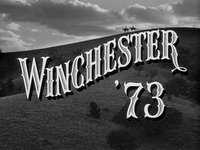 The second installment of the Anthony Mann series is actually the first collaboration between Jimmy Stewart and Mann. Winchester ’73 is everything that Wagstaff charges that The Far Country is not – fresh, energetic, and full of spirit. Supposedly, it was an afterthought tacked on to a two-picture deal between Stewart and Universal that included Harvey. With the exception of the premise, Harvey is a forgettable picture, yet Winchester stands up. It was a break-out film for Mann, following on the heels of several noir flicks that began his steady ascent to a major A-list director. For Stewart, it was a reinvention of his screen persona that, according to him at least, saved his acting career and gave him focus.
The second installment of the Anthony Mann series is actually the first collaboration between Jimmy Stewart and Mann. Winchester ’73 is everything that Wagstaff charges that The Far Country is not – fresh, energetic, and full of spirit. Supposedly, it was an afterthought tacked on to a two-picture deal between Stewart and Universal that included Harvey. With the exception of the premise, Harvey is a forgettable picture, yet Winchester stands up. It was a break-out film for Mann, following on the heels of several noir flicks that began his steady ascent to a major A-list director. For Stewart, it was a reinvention of his screen persona that, according to him at least, saved his acting career and gave him focus.The Stewart/Mann films are credited with creating the psychological western and advancing the genre to a more sophisticated adult audience. Yet, all that wasn’t quite developed in Winchester. Aside from Lin McAdam’s (Stewart) quest for revenge, he doesn’t have the dark side present in Stewart’s other characters in subsequent Mann films. He’s pretty much wearing a Tom Mix hat under the sweaty William S. Hart hat shown on the screen. There’s an interesting dichotomy between good brother (Stewart) and bad brother, aka Dutch Henry Brown, (Stephen McNally ), which was well-trodden territory for noir, but perhaps a little bit of a novelty for the western. The conflict between the two characters is powerful and exceptionally depicted by the two actors, but ultimately not complex in a psychological way. That’s not to suggest Winchester has little to say. Almost every shot has an alpha male in it, either establishing dominance or losing it – a natural theme since the story more or less follows the Winchester rifle exchanging hands.
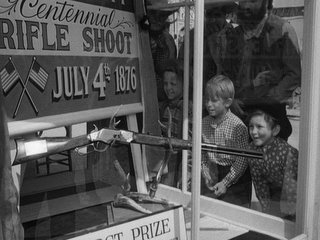 When the Winchester, one in a thousand, is first seen, it is by little prairie dust urchins gazing through the shop glass as if at a toy store. They can lick their lips all they want, but none of them are man enough to win it.
When the Winchester, one in a thousand, is first seen, it is by little prairie dust urchins gazing through the shop glass as if at a toy store. They can lick their lips all they want, but none of them are man enough to win it.
That’s right, win it! It wouldn’t be right to sell such a beautiful precision crafted thunder stick. It’s for special men. President Grant has one. To get this one, it’s going to take a shooting contest that will stretch the audience’s suspension of disbelief so taut that for the rest of the picture it will be like the exhausted elastic band on some old threadbare underwear. After the bulk of sharp shooting contestants are weeded out, two remain – two brothers, who happen to be arch enemies with a shared hate so strong that earlier in the picture they tried to shoot each other without guns. When armed, these two men can shoot. After it was determined that the targets weren’t good enough to pick a winner, they shot at coins – and finally a piece of hollowed out silver off the neck of Chief Yowlachie.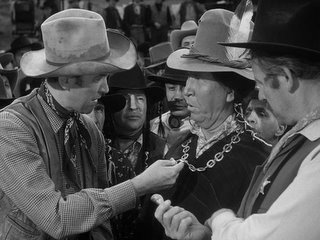
“Looks like another miss”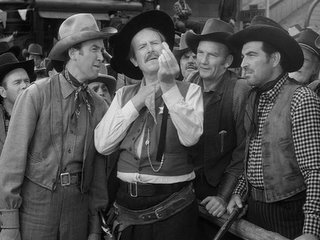
"I wouldn’t wanna say you’re wrong, Marshal, but I didn’t miss it." 
"I don’t see any mark, except maybe this scratch on the inside rim." 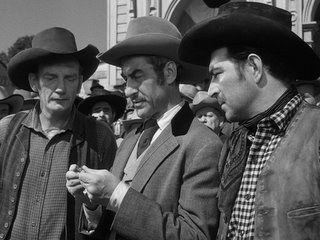
"That was my mistake. I shot through it."
Yeah, sure you did, you lying son of bitch!….or so I thought. But he proved me wrong with a postage stamp.
Still, winning the Winchester is not the same thing as keeping the Winchester. His bad seed bro lays out for him in the hotel room and steals it.

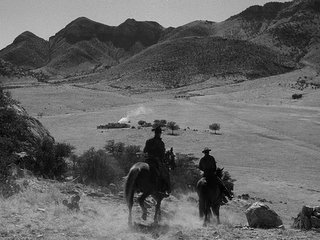 Everybody goes to Riker’s.
Everybody goes to Riker’s.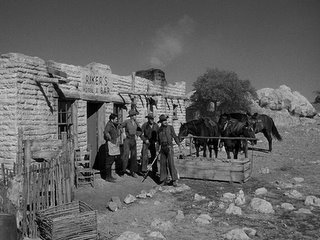 Dutch Henry Brown has the rifle, but not much else. There’s scuttlebutt that the indians are on the war path since the victory at the Little Big Horn (which would've happened 3 years after the story, but I digress)[actually, as the comment below the post points out, the shooting contest was in 1876, evidenced by the screenshot of the rifle behind glass, not 1873 as I assumed, so the historical timeline is accurate]. His posse needs guns. They meet a gun peddler (John McIntire) at Riker’s. He’s got a deal with some indians. If Anthony Mann pictures teach you anything, it’s that you should never sell repeating rifles to indians – especially when they're on the warpath. Yet, the peddler is like a cockroach, an inevitable opportunist.
Dutch Henry Brown has the rifle, but not much else. There’s scuttlebutt that the indians are on the war path since the victory at the Little Big Horn (which would've happened 3 years after the story, but I digress)[actually, as the comment below the post points out, the shooting contest was in 1876, evidenced by the screenshot of the rifle behind glass, not 1873 as I assumed, so the historical timeline is accurate]. His posse needs guns. They meet a gun peddler (John McIntire) at Riker’s. He’s got a deal with some indians. If Anthony Mann pictures teach you anything, it’s that you should never sell repeating rifles to indians – especially when they're on the warpath. Yet, the peddler is like a cockroach, an inevitable opportunist.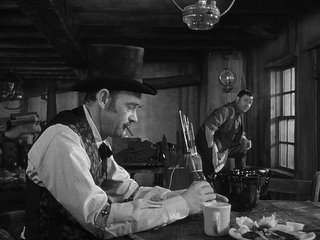 If you never thought that Rock Hudson would don redman blackface and scalp your sorry ass, well you better think again. He ends up getting the rifle off the peddler.
If you never thought that Rock Hudson would don redman blackface and scalp your sorry ass, well you better think again. He ends up getting the rifle off the peddler.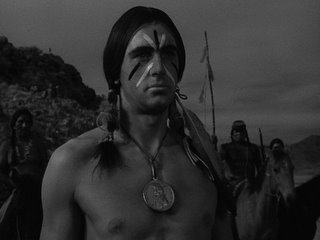 While Lin (Stewart) trails his bad bro and the rifle, the rifle changes possesion countless times. A few of its brief keepers:
While Lin (Stewart) trails his bad bro and the rifle, the rifle changes possesion countless times. A few of its brief keepers:Young Bull – apparently he earned his name by claiming he was an indian.

Steve Brody – he was never man enough to have the Winchester in the first place. He’s plagued by a yellow streak. On his arm is Lola Manner (Shelly Winters). Poor bastard, his rifle is too much gun for him and his fiance is too much woman for him. And see the white horse in tow?
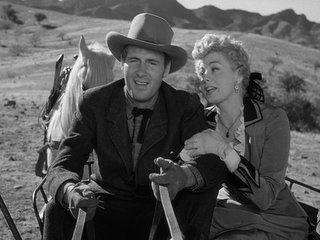
Waco Johnnie Dean (Dan Duryea) –
 at first glance, he’s just a wild brute, but because he’s the only character smart enough to understand his place in the food chain, well, that makes him pretty much the deepest character in the picture. Dan Duryea is one hell of an actor and the cocky S.O.B. steals every scene he’s in, which is quite an accomplishment as the film is brimming with excellent performances.
at first glance, he’s just a wild brute, but because he’s the only character smart enough to understand his place in the food chain, well, that makes him pretty much the deepest character in the picture. Dan Duryea is one hell of an actor and the cocky S.O.B. steals every scene he’s in, which is quite an accomplishment as the film is brimming with excellent performances.The film ends with the good brother chasing the bad. See the giant cacti?
 Those things are crawling all over Kansas.
Those things are crawling all over Kansas.The climax is a rifle duel on the side of a mountain:
“…The old man told you never to waste lead! Now you’re short!" Lin says to his evil brother.
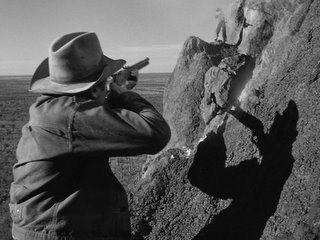 End picture.
End picture.What makes Winchester ‘73 so worthwhile in the end isn’t some chase after an adult themed western, but its purity within the genre. Winchester ’73 doesn’t pretend to be ambitious, but it’s expertly paced. For a 90 minute picture, it packs it all in: good shooting, nice scenery, lots of horses, indians, gamblers, thugs, cheats, dancers. Every time there’s a change in the film, the audience is taken to a new scene in medias res. The indian menace, as in many Mann pictures, plays out largely off screen. By the time the main characters face the menace for the first time, it's when they stumble upon an army unit that's already near the end of a Zulu-like siege. Unlike most recent westerns, all the action and multiple characters doesn’t bog down the film. It remains streamlined and focused and ends with one clearly defined climax. Realism doesn’t have a place in Winchester ’73, but nevertheless, Mann’s west is richly textured and full of life. Once “The End” flashes on the screen, you know you’ve really seen a western.








.jpg)






3 comments:
"Dan Duryea is one hell of an actor". Amen to that. His work in Fritz Lang's SCARLET STREET and WOMAN IN THE WINDOW is just stellar.
You have a great site. Thw Winchester 73 info is GREAT. I do need to make one correction: You stated that the Battle of the Little Big Horn was fought 3 years after the movie period. This is incorrect. The story line is correct. The target shoot was July 4, 1876 and the Little Big Horn Battle was fought June 25 & 26, 1876. Thanks for a great site!
Thanks for alerting me to the error, Anonymous. It has been corrected in the post.
Post a Comment